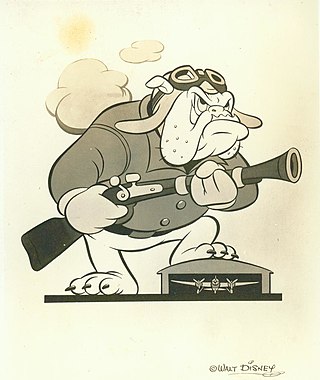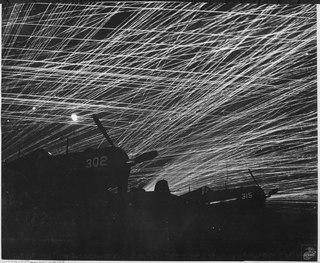
The Marine Corps Air Ground Combat Center (MCAGCC), also known as 29 Palms, is the largest United States Marine Corps base. The base covers a total area of 1,102 square miles.

The Bofors 40 mm Automatic Gun L/60 is an anti-aircraft autocannon, designed in the 1930s by the Swedish arms manufacturer AB Bofors. The gun was designed as an intermediate anti-aircraft gun, filling the gap between fast firing close-range small calibre anti-aircraft guns and slower firing long-range high calibre anti-aircraft guns. The Bofors 40 mm L/60 was for its time perfectly suited for this role and outperformed competing designs in the years leading up to World War II in both effectiveness and reliability.

The 9th Infantry Division is an inactive infantry division of the United States Army. It was formed as the 9th Division during World War I, but never deployed overseas. In later years it was an important unit of the U.S. Army during World War II and the Vietnam War. It was also activated as a peacetime readiness unit from 1947 to 1962 at Fort Dix, New Jersey, and Fort Carson, Colorado, and from 1972 to 1991 as an active-duty infantry division at Fort Lewis, Washington. The division was inactivated in December 1991.

The M42 40 mm Self-Propelled Anti-Aircraft Gun, or "Duster," is an American armored light air-defense gun built for the United States Army from 1952 until December 1960, in service until 1988. Production of this vehicle was performed by the tank division of the General Motors Corporation. It used components from the M41 light tank and was constructed of all-welded steel.

The 7th Marine Regiment is an infantry regiment of the United States Marine Corps based at Marine Corps Air Ground Combat Center Twentynine Palms, California. Nicknamed the "Magnificent Seventh", the regiment falls under the command of the 1st Marine Division and the I Marine Expeditionary Force.

The 1st Battalion, 7th Marines (1/7) is an infantry battalion of the 7th Marine Regiment of the United States Marine Corps. It is currently based at the Marine Corps Air Ground Combat Center Twentynine Palms. Consisting of approximately 1,000 Marines, it is part of the 1st Marine Division.

Combat Logistics Regiment 27 is a logistics regiment based at Marine Corps Base Camp Lejeune, North Carolina and falls under the command of the 2nd Marine Logistics Group and the II Marine Expeditionary Force, United States Marine Corps.
Battle of Chosin Reservoir order of battle is a list of the significant units that fought in the Battle of Chosin Reservoir between November 27, 1950 and December 13, 1950.

1st Light Antiaircraft Missile Battalion was a United States Marine Corps air defense unit equipped with the medium range surface-to-air MIM-23 HAWK Missile System. The battalion was the lineal descendant of the 1st Defense Battalion which gained fame during World War II for its defense of Wake Island early in the war. 1st LAAM also deployed to Vietnam in 1965 providing air defense for the Marine Corps in the I Corps sector. The battalion was last based at Marine Corps Air Station Yuma, Arizona and fell under the command of Marine Air Control Group 38 (MACG-38) and the 3rd Marine Aircraft Wing.

3rd Littoral Anti-Air Battalion is a United States Marine Corps aviation command and control and air defense unit that is optimized for operations in the first island chain. The battalion is based at Marine Corps Base Hawaii and falls under the command of the 3rd Marine Littoral Regiment and the 3rd Marine Division.
The 2nd 90mm Antiaircraft Artillery Gun Battalion was a United States Marine Corps antiaircraft unit that was active during the 1940s & 1950s. Originally formed during World War II as the 9th Defense Battalion, the battalion took part in combat operations on Guadalcanal, Rendova, Munda Point, and Guam. Like most other Marine defense battalions, the unit was re-designated in September 1944, becoming the 9th Antiaircraft Artillery Battalion. Returning to the United States in 1946, the battalion was again re-designated, this time as the 1st Antiaircraft Artillery Battalion. The battalion received its final designation as the 2nd 90mm Antiaircraft Artillery Battalion on August 21, 1950. It was later decommissioned on September 15, 1956 at Marine Corps Base 29 Palms, California.

The History of ground based air defense in the United States Marine Corps dates back to the early 1930s with the establishment of the Advanced Base Force. World War II would be the high-water mark for air defense units when 20+ defense/anti-aircraft battalions were formed with many seeing significant action throughout the Pacific Theater. Following the war, the Marine Corps divested itself of most of its air defense capability at a time when the service was facing deep personnel cuts and fighting for its institutional survival. Beginning in the early 1950s the Marine Corps aligned itself with the Navy and their development of surface-to-air missiles (SAMs). The Marine Corps retained both flak weapons and SAMs throughout the 1950s until the fielding of the MIM-23 Hawk Missile System in 1960. The HAWK Missile was employed by Light Antiaircraft Missile (LAAM) battalions and remained a mainstay of Marine Corps ground based air defense for the next four decades.

On 21 July 1944, United States Marine and Army forces invaded the island of Guam, the southernmost of the Mariana Islands chain in the Central Pacific, with the intent to take control of the island from the Imperial Japanese Army. Operation Forager II, as it was called by American planners, was a phase of the Pacific Theatre of World War II.
The 16th Antiaircraft Artillery Battalion was a United States Marine Corps antiaircraft unit that served during World War II. Formed in 1942 as the 16th Defense Battalion, its original mission was the air and coastal defense of advanced naval bases. During the war the battalion defended Johnston Island, Hawaii and Tinian and took part in combat operations at Okinawa. The battalion returned to the United States after the war and was decommissioned on 30 November 1945 at Marine Corps Base Camp Pendleton, California.

The 12th Antiaircraft Artillery Battalion was a United States Marine Corps antiaircraft unit that served during World War II. Formed in 1942 as the 12th Defense Battalion, its original mission was providing air and coastal defense for advanced naval bases. During the war the battalion defended the Russell Islands and took part in combat operations at Woodlark Island, Cape Gloucester, and Peleliu. The battalion remained on Peleliu for the duration of the war and was finally decommissioned on Guam on 22 September 1945.

The 2d Antiaircraft Artillery Battalion (Composite) (2d AAA Bn [Composite]) was a United States Marine Corps antiaircraft unit that served during World War II. Formed in 1943 as the 3d Airdrome Battalion, its original mission was strictly providing air defense. On 1 October 1943 the battalion was redesignated the 18th Defense Battalion. During the war the battalion provided air defense for the Saipan and Tinian area of operations. The battalion returned to Marine Corps Base Camp Lejeune, North Carolina after the war receiving its final designation on 16 May 1946. The battalion was decommission in September 1947.

The 17th Antiaircraft Artillery Battalion was an antiaircraft unit in the United States Marine Corps that served during World War II. The battalion was originally formed in 1942 as the 2d Airdrome Battalion and has the distinction of being the last defense battalion formed in the Marine Corps during the war. Its original mission was to provide air and coastal defense for advanced naval bases. During the war the battalion spent significant time defending Nukufetau and took part in combat operations at Tarawa and Tinian. The battalion was decommissioned on December 6, 1945.
The 15th Antiaircraft Artillery Battalion was an antiaircraft unit in the United States Marine Corps that served during World War II. The battalion was originally formed in 1942 as the 1st Airdrome Battalion. Its original mission was to provide air defense for advanced naval bases. During the war the battalion took part in combat operations in the Marshall. The battalion was one of the first defense battalions to be decommissioned on November 25, 1944.
The 14th Antiaircraft Artillery Battalion was an antiaircraft unit in the United States Marine Corps that served during World War II. The battalion was originally formed in 1943 as the 14th Defense Battalion. Its mission was to provide air and coastal defense for advanced naval bases. During the war the battalion took part in combat operations in the Solomon Islands and on Guam. The battalion was decommissioned on June 30, 1945. Since then no other unit has carried the lineage and honors of the 14th Antiaircraft Artillery Battalion.

The 1st Provisional Antiaircraft Artillery Group was a provisional unit that served as the headquarters for all United States Marine Corps antiaircraft battalions that participated in the Battle of Okinawa. The group was formed on Kauai, Territory of Hawaii in November 1944 under the command of the III Marine Amphibious Corps. For the Battle of Okinawa, the group was under the command of the 53d Antiaircraft Artillery Brigade of the Tenth United States Army and was responsible for air defense of the area surrounding Yontan & Kadena Airfields. Following the end of the war, the group returned to the United States and was decommissioned on December 5, 1945. To date, no other Marine Corps unit has carried the group's lineage and honors















